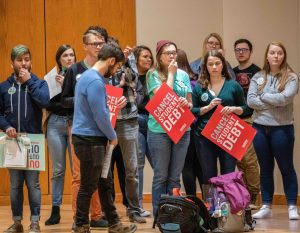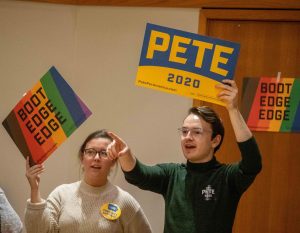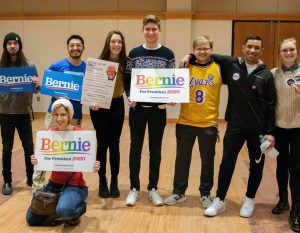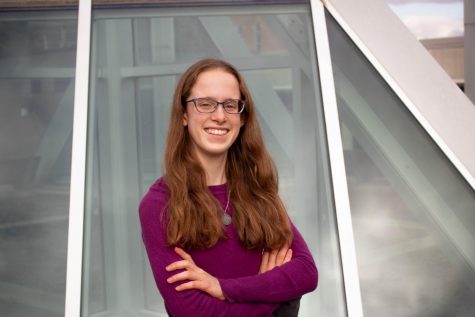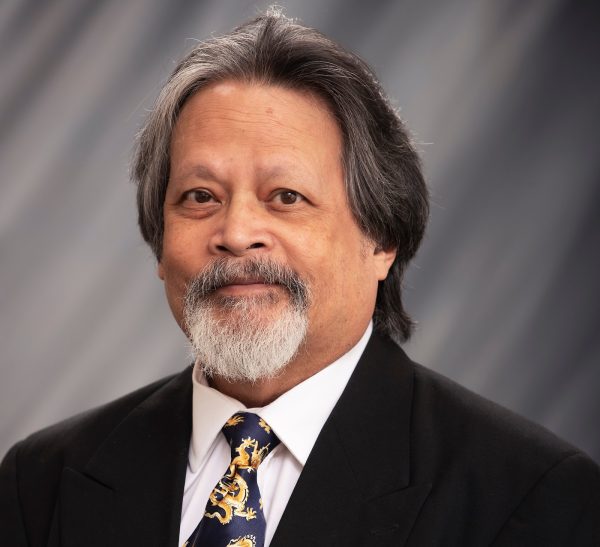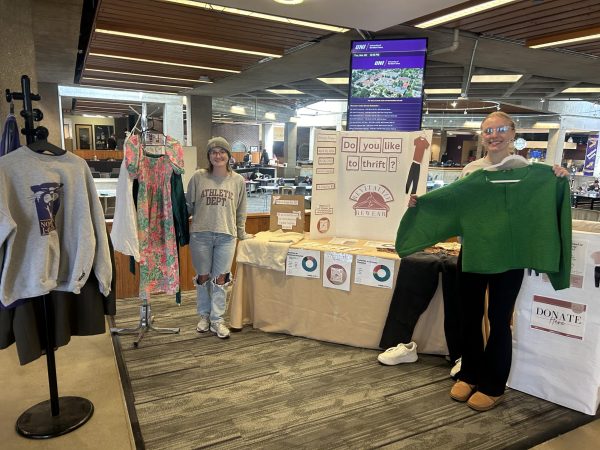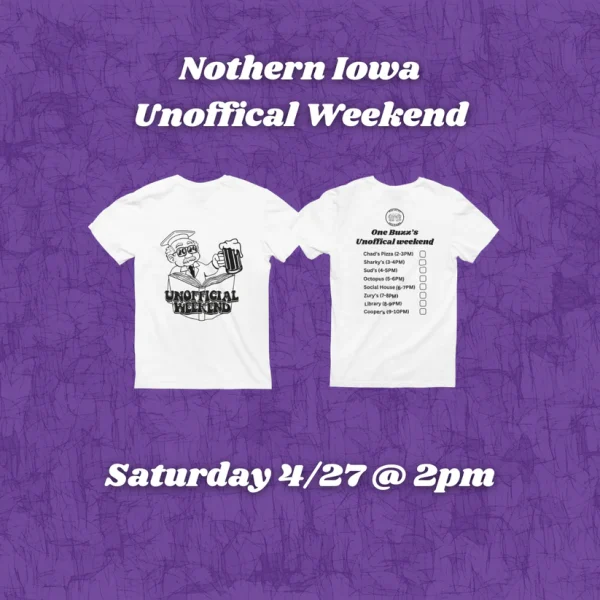UNI hosts mock caucus in Maucker
Jan 30, 2020
“This may be a little chaotic, but that’s kind of what a caucus is like,” said political science professor Donna Hoffman, addressing UNI students and community members in the Maucker Union Ballroom on Monday, Jan. 27 at 7 p.m.
Attendees were there to participate in the UNI Mock Caucus, hosted by the American Democracy Project, Northern Iowa Student Government (NISG) and the UNI political science department. The event, held one week before the Iowa caucuses on Feb. 3, was intended to introduce students to the caucus process and the role it plays in the American
democratic system.
As Hoffman called the group to order, she stressed the value of Iowans’ unique experience of being “first in the nation” in the caucusing process.
“I want you to raise your hand if you’ve met a presidential candidate this cycle,” she said.
A majority of the attendees raised their hands.
“Almost everybody here. Now, if I asked that question in virtually any other state […], I probably wouldn’t get any hands.”
Hoffman opened with a general explanation of the caucus process, including how to find your ward and precinct location, which she said is likely different from your polling place during general elections. Caucus-goers can register or change their party registration on the night of the caucus (since you must be a registered party member to participate), although Hoffman advised that those who need to do so should arrive early to complete the paperwork. Caucuses for both parties will start at 7 p.m.
Hoffman said that although the selection of candidates is the most anticipated function of caucuses, the events play other critical roles for political parties, such as electing delegates to the county convention and elevating party platform planks. This is because caucuses are run by political parties, while the primary elections in states such as New Hampshire are run by state governments.
“A precinct caucus is the first stage of a grassroots process where you’re getting to participate in democracy,” Hoffman said. “Make sure that you stick around for the important party-building things that are done at these events.”
The mock event began with a simulation of the Republican caucus. Although President Trump is the presumed Republican nominee, Republican caucuses will still be held. Candidates for the Republican nomination are former Illinois Rep. Joe Walsh and former Massachusetts governor Bill Weld.
To simulate the Republican caucus, attendees recorded their preferred candidate (or “no preference”) on anonymous candidate preference cards, which were collected and tabulated. Since many attendees were Democratic supporters, the Republican “winner” was the “no preference” option.
After the Republican process concluded, political science professor Chris Larimer opened the mock Democratic caucus. He explained a key change to the Democratic process for 2020 — although attendees will still indicate support by standing in areas of the room assigned to each candidate, they will also fill out an initial candidate preference form similar to the Republican caucus. These forms will help the Democrats report more data on the caucuses than they have done in the past.
After distributing the forms, Larimer announced in which area of the room supporters of each candidate should stand. Cheering and waving signs, supporters made their way to their designated area or to the “unaffiliated” location if they had not yet selected a candidate.
Once groupings had been established, organizers counted the number of supporters in each area. To remain viable, each candidate must garner at least 15% of caucus attendees. At the mock caucus, the 125 voting participants meant that to be viable, a candidate needed at least 19 supporters.
After the first alignment, three candidates — Joe Biden, Tulsi Gabbard and Amy Klobuchar — had not garnered enough support to be viable.
“On caucus night, if that happens, you will have 15 minutes to realign,” Larimer said, addressing the supporters of the non-viable candidates. “For the supporters of all the other viable candidates, you need to stay in your group.”
As the non-viable supporters realigned, Larimer and Hoffman emphasized that after the first alignment, members of viable groups cannot change.
“On your first alignment, if the group you are in is viable, even if it’s unaffiliated, you’re locked into that — you don’t get to realign,” Hoffman said.
After the realignment, organizers counted the five remaining groups. Pete Buttigieg and Andrew Yang both garnered 24 supporters, Bernie Sanders drew 30 and Elizabeth Warren had 34. 29 participants were unaffiliated. Based on the “caucus math,” said Larimer, all five candidates, including the unaffiliated group, would receive two delegates.
Junior art history major Katelyn Brockmeyer, who plans to caucus for Warren, attended the event to “learn the ropes” before she volunteers as a caucus chair in next week’s event. Brockmeyer caucused as a Republican in 2016 and said the UNI mock event helped her feel more confident in the Democratic process.
“I think it’s important for people to get out and exercise their caucus and their vote,” she said. “I know a lot of people […] that care about the issues and don’t like our current president, and I just want them to know that they have the power to change that.”
Emmett Cory, a fifth-year psychology and family services major who plans to caucus for Warren, agreed.
“A lot of people wait until after the caucus to see who they should get behind, but I think taking part in that process is really important,” he said.





